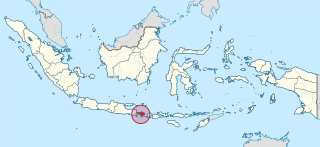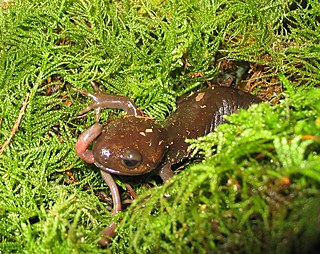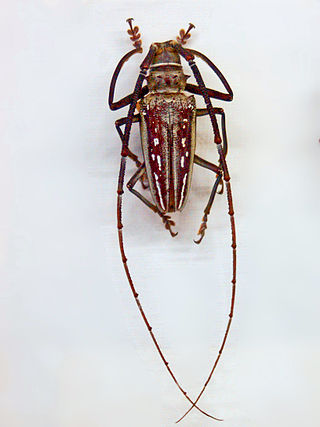Related Research Articles

Bali is a province of Indonesia and the westernmost of the Lesser Sunda Islands. East of Java and west of Lombok, the province includes the island of Bali and a few smaller offshore islands, notably Nusa Penida, Nusa Lembongan, and Nusa Ceningan to the southeast. The provincial capital, Denpasar, is the most populous city in the Lesser Sunda Islands and the second-largest, after Makassar, in Eastern Indonesia. The upland town of Ubud in Greater Denpasar is considered Bali's cultural centre. The province is Indonesia's main tourist destination, with a significant rise in tourism since the 1980s. Tourism-related business makes up 80% of its economy.

Beetles are insects that form the order Coleoptera, in the superorder Holometabola. Their front pair of wings are hardened into wing-cases, elytra, distinguishing them from most other insects. The Coleoptera, with about 400,000 described species, is the largest of all orders, constituting almost 40% of described insects and 25% of all known animal species; new species are discovered frequently, with estimates suggesting that there are between 0.9 and 2.1 million total species. Found in almost every habitat except the sea and the polar regions, they interact with their ecosystems in several ways: beetles often feed on plants and fungi, break down animal and plant debris, and eat other invertebrates. Some species are serious agricultural pests, such as the Colorado potato beetle, while others such as Coccinellidae eat aphids, scale insects, thrips, and other plant-sucking insects that damage crops.

The family Scarabaeidae, as currently defined, consists of over 35,000 species of beetles worldwide; they are often called scarabs or scarab beetles. The classification of this family has undergone significant change in recent years. Several subfamilies have been elevated to family rank, and some reduced to lower ranks. The subfamilies listed in this article are in accordance with those in Catalog of Life (2023).

The Curculionidae are a family of weevils, commonly called snout beetles or true weevils. They are one of the largest animal families with 6,800 genera and 83,000 species described worldwide. They are the sister group to the family Brentidae.

The longhorn beetles (Cerambycidae), also known as long-horned or longicorns, are a large family of beetles, with over 35,000 species described. Most species are characterized by extremely long antennae, which are often as long as or longer than the beetle's body. In various members of the family, however, the antennae are quite short and such species can be difficult to distinguish from related beetle families such as the Chrysomelidae. The scientific name of this beetle family goes back to a figure from Greek mythology: after an argument with nymphs, the shepherd Cerambus was transformed into a large beetle with horns.

Buprestidae is a family of beetles known as jewel beetles or metallic wood-boring beetles because of their glossy iridescent colors. Larvae of this family are known as flatheaded borers. The family is among the largest of the beetles, with some 15,500 species known in 775 genera. In addition, almost 100 fossil species have been described.

Western New Guinea, also known as Papua, Indonesian New Guinea, Indonesian Papua, is the western, Indonesian half of the island of New Guinea. Since the island is alternatively named Papua, the region is also called West Papua.

Liang Bua is a limestone cave on the island of Flores, Indonesia, slightly north of the town of Ruteng in Manggarai Regency, East Nusa Tenggara. The cave demonstrated archaeological and paleontological potential in the 1950s and 1960s as described by the Dutch missionary and archaeologist Theodor L. Verhoeven.

The American elm cultivar Ulmus americana 'Aurea' was cloned from a tree discovered by F. L. Temple in Vermont at the end of the 19th century.
The American Elm cultivar Ulmus americana 'Iowa State' was cloned in the 1980s from a tree discovered by Professor Alexander (Sandy) McNabb of Iowa State University as the sole survivor in 40 acres (16 ha) of diseased elm at Burlington.

The Siberian elm cultivar Ulmus pumila 'Dwarf Weeper' was discovered in a western Illinois garden and sold by the Arborvillage Nursery Holt, Missouri.

Mount Halimun Salak National Park is a 400 km2 conservation area in the Indonesian province of West Java on the island of Java. Established in 1992, the park comprises two mountains, Mount Salak and Mount Halimun with an 11-kilometer forest corridor. It is located near the better known Mount Gede Pangrango National Park, but the national park should be accessed from Sukabumi, 2 hours drive to the administration post and then 2 hours drive again to Cikaniki post gate.
The American Elm cultivar Ulmus americana 'Flick's Spreader' was cloned from a tree discovered by John T. Flick on a farm near Hammon, Oklahoma. Cuttings were given to the Sunshine Nursery, Clinton, Oklahoma, in 1997, which later marketed the tree as 'Flick's Spreader'.

Vermivore is a zoological term for animals that eat worms. Animals with such a diet are known to be vermivorous. Some definitions are less exclusive with respect to the diet, but limit the definition to particular animals, e.g. "Feeding on worms or insect vermin. Used of a bird."

Trigonopterus oblongus is a weevil found in Papua. It was notable as the first known instance of a biological screw joint. The weevils are just 4 millimetres (0.16 in) long and can fold their legs below their body. The biological screw joint is just 0.5 millimetres (0.020 in) in size. This discovery was made by Alexander Riedel of the State Museum of Natural History Karlsruhe and by Thomas van de Kamp of the Karlsruhe Institute of Technology.
The International Institute for Species Exploration (IISE) is a research institute located in Syracuse, New York. Its mission is to improve taxonomical exploration and the cataloging of new species of flora and fauna. Since 2008, IISE has published a yearly "Top 10" of the most unusual or unique biota newly identified in the previous year, with the aim of drawing attention to the work done in taxonomy across the world over the previous year.

Batocera wallacei, common name Wallace's long-horn beetle, is a species of flat-faced longhorn beetle in the subfamily Lamiinae of the family Cerambycidae. The species name honors Alfred Russel Wallace, who discovered this longhorn beetle on the Aru Islands in Indonesia. It was named after him by James Thomson in 1858.

Ancyronyx, commonly known as spider water beetles or spider riffle beetles, is a genus of aquatic riffle beetles from North America, South Asia, China, and Southeast Asia. They are small beetles with extremely long legs ending in strong claws. Both the adults and the larvae are found underwater in the shallow riffles of streams and rivers, clinging to rocks or submerged wood. They feed on algae and decaying wood tissue. The genus contains twenty-one species, eleven of which are endemic to the Philippines.

Hyorhinomys stuempkei, the hog-nosed shrew rat or Sulawesi snouter, is a species of rodent in the family Muridae, more specifically in the subfamily Murinae, endemic to Sulawesi, Indonesia. This species was discovered in 2015 by Jacob A. Esselstyn and his team, Anang S. Achmadi, Heru Handika, and Kevin C. Rowe", Esselstyn proposed "Sulawesi snouter" as a common name for it. The word "snouter" references the fictional text, The Snouters: Form and Life of the Rhinogrades by the German zoologist Gerolf Steiner. Steiner wrote this text as a fictional naturalist, Harald Stümpke, and the specific epithet of H. stuempkei pays homage to this fictional individual.

Ross Taylor Bell was an American entomologist with particular interest in the invertebrate natural history of Vermont, United States, and carabid beetles. Together with his wife, Joyce Rockenbach Bell, his work at the University of Vermont was largely taxonomic, where they described more than 75% of the rhysodine species known to science. Ross also wrote a number of seminal papers in his chosen field.
References
- ↑ Melina, Remy (7 July 2011). "4 Species of Jewel Beetles Discovered". livescience.com. Future US Inc. Retrieved 26 October 2023.